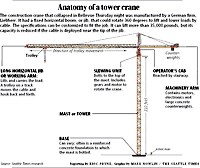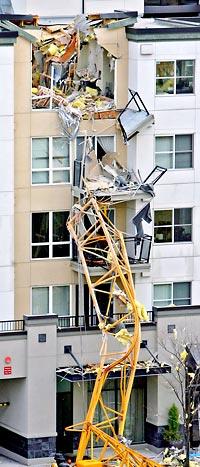Winds may have weakened crane

High winds earlier this week may have weakened metal fasteners in the base of a giant construction crane that collapsed in Bellevue Thursday night, killing one man and severely damaging three downtown buildings.
"That's what we're focusing on," Charles Lemon, crane-safety specialist for the state Department of Labor and Industries, said Friday.
Dozens of bolts and welds failed where the base of the crane was secured, Lemon said. The bolts connected the crane to large steel beams and a concrete slab in an underground parking garage at a corner of the construction site.
Winds had dropped when the crane collapsed Thursday, but stronger winds earlier in the week might have rocked the 210-foot tower crane and placed excessive stress on the base, Lemon said.
He said investigators would also examine the crane for structural problems that could have put stress on the base.
Lemon said the crane operator was preparing to close down at the time of the accident, and the crane was not carrying a load — virtually eliminating excessive weight as the cause of the collapse. The operator was trapped in the control cab of the crane about 30 feet off the ground after a plunge of nearly 200 feet, according to fire officials. Firefighters used a ladder to reach him, and he was able to walk away from the scene.
The crane had never been inspected by state officials, said John Ecker, compliance manager for Labor and Industries.
They inspect cranes only if there is a history of problems or a specific complaint from an employee or outside party, Lemon said. They are not allowed by law to make random visits, he said.
Lemon said he wasn't aware of any problems with the crane before the collapse.
The crane was erected Sept. 9 at the site of a 20-story office building under construction at the corner of Northeast Fourth Street and 108th Avenue Northeast in Bellevue, said Tamara Hardy, safety director for Northwest Tower Crane Service.
Hardy said her company constructed the crane tower, but that the design of the base was overseen by the general contractor, Lease Crutcher Lewis, and approved by an outside engineer.
Contractors are told to check cranes every day they are used, but they are not required to conduct a full structural evaluation, Lemon said.
Lemon said contractors are not required to check for metal fatigue after high winds, although it would be prudent.
It wasn't clear if Seattle-based Lease Crutcher Lewis or the crane's owner, Salem, Ore.-based Morrow Equipment, examined the crane after the windy weather. Neither Morrow nor Lease Crutcher Lewis responded to inquiries.
State inspectors on Friday found that three of four welds in the support beams had failed and that up to 72 bolts had been pulled from the concrete or sheared from the foundation, Lemon said.
He said a metallurgist was trying to determine if the failures resulted from weakened metal or if the crane fell over for some other reason, stripping the bolts and welds.
The National Weather Service reported sustained winds of 16 mph at Seattle-Tacoma International Airport Wednesday, with gusts of up to 41 mph. Earlier in the week, there were gusts between 26 mph and 38 mph.
Hardy, the Northwest Tower safety official, said the crane was not secured to a base made by its manufacturer. She said that was acceptable, as long as the custom base used by Lease Crutcher Lewis met standards and was approved by its engineer. It wasn't clear whether that was the case.
State officials said an engineer typically would design and approve the installation.
Workplace safety rules require operators to routinely inspect tower cranes according to "industry standards."
Although Lemon said those standards require an inspection every day a crane is used, the guidelines are less exact. For example, they state that cranes in "heavy service" shall be inspected "daily to weekly," while those in light service shall be checked monthly. More thorough annual inspections are required for all cranes.
Only the periodic inspections require record-keeping. Labor and Industries checks to see whether contractors comply with the standards only when there is a reported problem.
Steven Pfeiffer, engineering manager for Seattle's Department of Planning and Development, said local building inspectors focus on a final structure, not how it gets erected.
Because cranes are not part of the finished building, the bases on which they're built fall outside the routine inspections. For example, a concrete platform on which a tower crane sits would not be inspected unless the platform was going to become part of the final building.
"We deliberately stay out of that because we don't have the resources to stay on top of that kind of thing," Pfeiffer said, explaining that government monitoring of the "means and methods" of construction would require an almost constant presence on construction sites.
Instead, the operator is responsible for the safe operation and construction of a crane, according to L&I.
On Friday, L&I issued an advisory to operators, urging them to search their cranes for structural problems and reminding them of their responsibility to inspect cranes according to the industry standards.
Lease Crutcher Lewis has been cited by L&I for three serious workplace safety violations in Seattle and Bellevue since 2003. Ness Cranes, whose employee was operating the crane when it collapsed Thursday, was cited once in 2005, according to L&I records. Details of those incidents were not immediately available. Northwest Tower Crane Service, based in Tukwila, has been cited for six serious safety violations in Bellevue and Seattle since 2002.
It was not clear if any of the past violations against each company occurred at the site of Thursday's accident.
Times staff reporter Peyton Whitely contributed to this story.
Steve Miletich: 206-464-3302 or smiletich@seattletimes.com
Susan Kelleher: 206-464-2508 or skelleher@seattletimes.com
